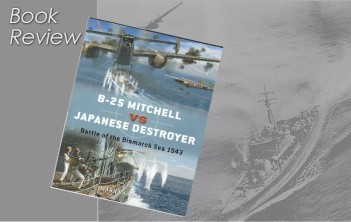Introduction
B-25 Mitchell vs Japanese Destroyer Battle of the Bismarck Sea 1943 is a new book in the series Duel, title number 116. Authored by Mark Lardas and illustrated by Jim Laurier, the book is 80 pages of content, including color artwork and cutaway artwork. You can find it catalogued with the Osprey Short Code DUE 116 or as ISBN 978-1-4728-4517-7. While this review looks at the softcover book, it is also available in PDF and ePUB formats.
It is practically impossible to read about the war in the South Pacific without finding images and stories of American bombers attacking Japanese ships at low level. Special tactics and highly modified aircraft created outside United States Army Air Force (USAAF) doctrine were the key to the success of the campaign against Japanese shipping. Their attacks were critical to dislodging the Japanese Army (IJA) from conquered territory. They forced the Japanese Navy (IJN) to adapt their ships and operations to counter the predatory bombers. Those attacks produced some of the most extraordinary photographs of the air-sea war. If you have wondered why these big airplanes flung themselves against Japanese ships, and how well the ships countered them, this book presents a detailed story about those combats. With first-hand accounts and after-action reports, the author simplifies and condenses the record of those clashes, the most notorious battle being the Battle of the Bismarck Sea.
Osprey writes of this title:
Throughout the first year of the war in the Pacific during World War II the USAAF was relatively ineffective against ships. Indeed, warships in particular proved to be too elusive for conventional medium-level bombing. High-level attacks wasted bombs, and torpedo attacks required extensive training. But as 1942 closed, the Fifth Air Force developed new weapons and new tactics that were not just effective, they were deadly. A maintenance officer assigned to a B-25 unit found a way to fill the bombardier's position with four 0.50-cal machine guns and strap an additional four 0.50s to the sides of the bomber, firing forward. Additionally, skip-bombing was developed. This called for mast-top height approaches flying the length of the target ship. If the bombs missed the target, they exploded in the water close enough to crush the sides. The technique worked perfectly when paired with "strafe” B-25s.
Over the first two months of 1943, squadrons perfected these tactics. Then, in early March, Japan tried to reinforce their garrison in Lae, New Guinea, with a 16-ship convoy - eight transports guarded by eight destroyers. The Fifth Air Force pounced on the convoy in the Bismarck Sea. By March 5 all eight transports and four destroyers had been sunk.
This volume examines the mechanics of skip-bombing combined with a strafing B-25, assessing the strengths and weaknesses of the combatants (B-25 versus destroyer), and revealing the results of the attacks and the reasons why these USAAF tactics were so successful.
This title presents and explains how American B-25s evolved from mediocre anti-shipping weapons to sweeping the seas of Japanese commerce, despite defenses of Japan's excellent destroyers.
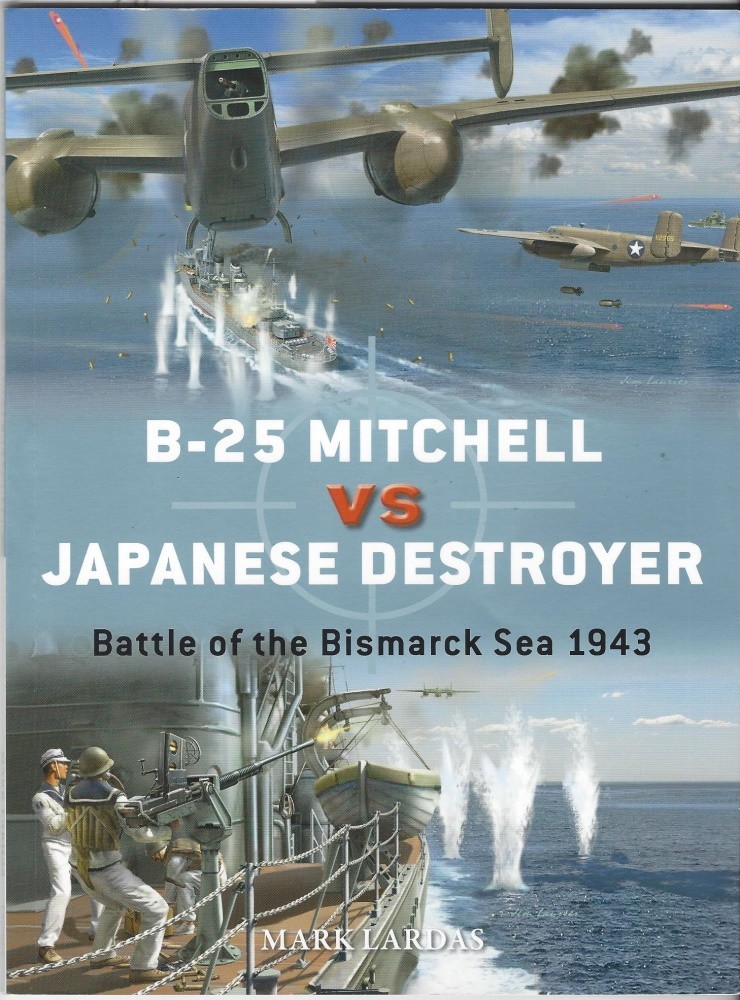
Content
PB-25 Mitchell vs Japanese Destroyer is told through 11 chapters and subsections in 80 pages:
- Introduction
- Chronology
- Design and Development
- Technical Specifications
- The Strategic Situation
- The Combatants
- Combat
- Statistics and Analysis
- Aftermath
- Further Reading
- Index
Well-written and detailed text presents this exploration of that amazing aspect of the war. Callout boxes are used for specific and important subjects. First-hand accounts spice up the narrative, i.e.;
When within strafing range I opened fire with my forward guns. The decks were covered with troops lined up facing the attacking plane with rifles in hand. However, my 0.50-cal. machine guns outranged their small arms and I saw hundreds fall.
To understand the war between B-25s and Japanese destroyers and other ships, it is imperative to understand the technical and tactical capabilities of the subject bomber and warship, and the weapons used against each other. Introduction and Chronology lay out the background and and timeline of the destroyer-Mitchell war. Interestingly, most Duel chronologies conclude with the end of the war but this one spans through a B-25-destroyer milestone in 1971. Design and Development and Technical Specifications cover a full 32 pages. Within that page constrain the author does a thorough job of covering the design, redesigns, variants and modifications, and histories of these combatants. The amazing story of the legendary “Pappy” Gunn’s modifications is covered in good detail. Japan’s destroyer designs are explained as well, focusing on their strengths and weaknesses with offensive and defensive weaponry, numbers and eras built, and how they compared to Allied destroyers. Mr. Lardas is a naval architect and explains engineering aspects expertly. He even compares IJN boiler specifications and performace with those of USN. The composition and roles of B-25 crews changed and he covers that in good detail. Powerplants, weapon and ordnance performance and capability is also covered very well. As the weapons changed, the reasons are covered, as well as changes in operational impact and tactics.
The Strategic Situation covers the war conditions which lead to the Battle of the Bismarck Sea, from Japan’s reason to start the war and their strategies, through the fortunes in the South Pacific, and the Allied opposition. In The Combatants we learn of the socioeconomic backgrounds, training, and physical and technical characteristics of the associated American and Japanese personnel, so detailed as to include Japanese Navy retirement information. Two full-page biographies introduce Rear Admiral Masatomi Kimura and the legendary Major Paul Irvin “Pappy” Gunn. While this book is about B-25s and destroyers and not Pappy Gunn, it is fan-boy time: one page does not do justice to Pappy Gunn; it is implausible that the Japanese could have invaded Australia but without Gunn’s special modifications to A-20s and B-25s, the road to Tokyo would probably have taken much more blood and time. Gunn worked beyond legend to do what he did, and was famous/notorious for how he achieved his results; he was a man possessed as his wife and four children vanished in the Japanese occupation of the Philippines, and Gunn knew what was happening to civilians in China. It was said Gunn’s hatred for the Japanese was exceeded only by his hatred of General MacArthur, who Gunn believed had promised that he could fly back and evacuate his family but then forbade it when the time came. But this is a book about B-25s verses Japanese shipping. Though there are a few good books on Major Gunn, maybe Osprey will publish a history of him or strafer bombers.
Finally, Combat provides the history of the clashes between the B-25 and IJN ships. It starts out recounting the development and employment of low-level, mast-height, and skip-bombing. The Bismarck Sea battle is the main subject and the subsequent use of B-25s low-level are covered. Statistics and Analysis and Aftermath provides the results of B-25s upon Japanese shipping, and the ability of IJN destroyers to counter the bombers.
I find the text to be generally well researched and smartly composed, with surprising detail. Several callout boxes emphasize important subjects, i.e., ship identification. It is not flawless and I found mistakes: an exaggerated maximum speed on page 10; transposing of maximum and effective ranges of anti-aircraft guns on page 39. A curious error is the description of the low-level bomb runs as parallel to the ships, which is contrary to tactics augmented to Air Corps Field Manual 1-10 and subsequent tests at Eglin Field in 1942; perhaps this mistake is because of the photos used, most of which show bombers attacking ships parallel or with a low angle-off; in Mr. Lardas' defense the field manual did stipulate that the ideal attack against a ship was along the fore and aft axis, approaching from the stern.* Otherwise, this concise history of the warriors of the Bismarck Sea battle is one of the more impressive Duel books I have read.
Photos, Artwork, Graphics
A fascinating gallery of photographs reinforce the text. Most photos have been used in other books over the decades but there are a few that are new to me. I have never seen an interior of a Japanese destroyer until this book. A view through a maintenance building at a Port Moresby airfield is very interesting. A great number of the photos are combat shots from/of B-25s attacking IJN ships. There are even a few color photographs. Modelers can find excellent reference photos, even to inspire a diorama. And while not photographs per se, wartime technical art enhances the gallery.
Original color artwork is provided by Jim Laurier.
Artwork
1. Two-page combat scene Type 93 Model 1933 13mm 0.52-cal. Machine Gun and crew firing upon a B-25; narrated through a 2/3-page callout box.
2. Illustrations: Skip bombing and Mast-top bombing illustrating B-25 flight profiles to attack a ship, in profile and planform.
3. Fubuki-class Type C 127mm gun turret general arraignment: line art of the profile, planform and rear, keyed to 26 components.
4. Asashio-class destroyer: detailed halftone for aircrew identification by the US Office of Naval Intelligence; profile and planform; key data.
5. AN-M64 500lb Bomb: cutaway and explained in a callout box.
6. B-25G M2 0.50-cal. Machine Guns: captioned three-quarter view of the B-25G nose weapons with the cowing open.
7. Line art three-quarter view B-25G and T-13E1 M5 75mm cannon installation.
8. B-25C Mitchell Strafer Cockpit keyed to 71 components.
9. Shirayuki: Fubuki-class destroyer in profile and planform.
10. B -25D Mitchell in profile, planform, and the business end.
Map
Battle of the Bismarck Sea area, keyed to airbases, naval bases, route of convey, and area where the attacks were made.
Tables
1. Japanese Order of Battle, Battle of the Bismarck Sea: escorts and convoy ships by name, class, name translated to English; Commanding officers; IJA units aboard; IJN ground units aboard.
2. Allied Order of Battle, Battle of the Bismarck Sea: fighter and bomber groups by squadron; Commanding officers; aircraft types.
3. Gun Specifications. Six dimensional and performance metrics of the:
a. Type 96 Model 1 25mm antiaircraft cannon;
b. Type 93 Model 1939 13mm machine gun.
4. Fubuki-class Destroyer Specifications: powerplants; dimensions; weights; performance; weapons.
5. Performance Specifications: engines, boilers, horsepower, maximum speed and range of three IJN destroyer classes:
a. Fubuki
b. Asashio
c. Kagero
6. Principle Dimensions of the three classes above.
7. B-25C/D Specifications: engines; dimensions; weights; performance; payload and weapons.
8. M-58/58A1 General Purpose Bomb Specifications: 11 characteristics.
9. Browning M2 0.50-cal. Machine Gun Specifications: 12 characteristics.
That graphic content does an excellent job of enhancing and supporting the text.
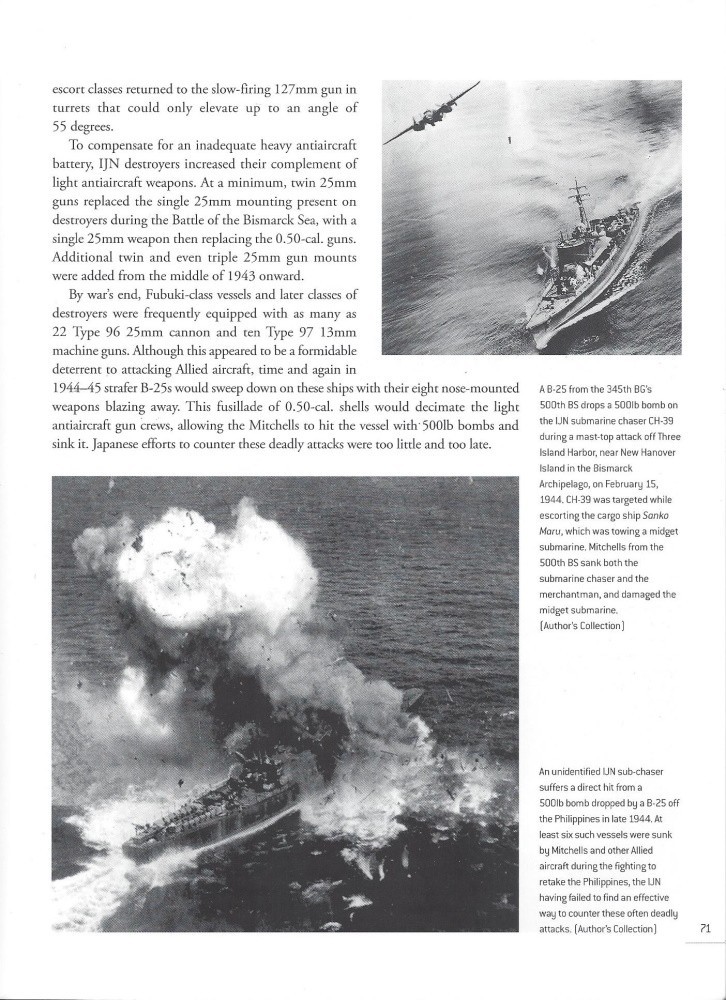
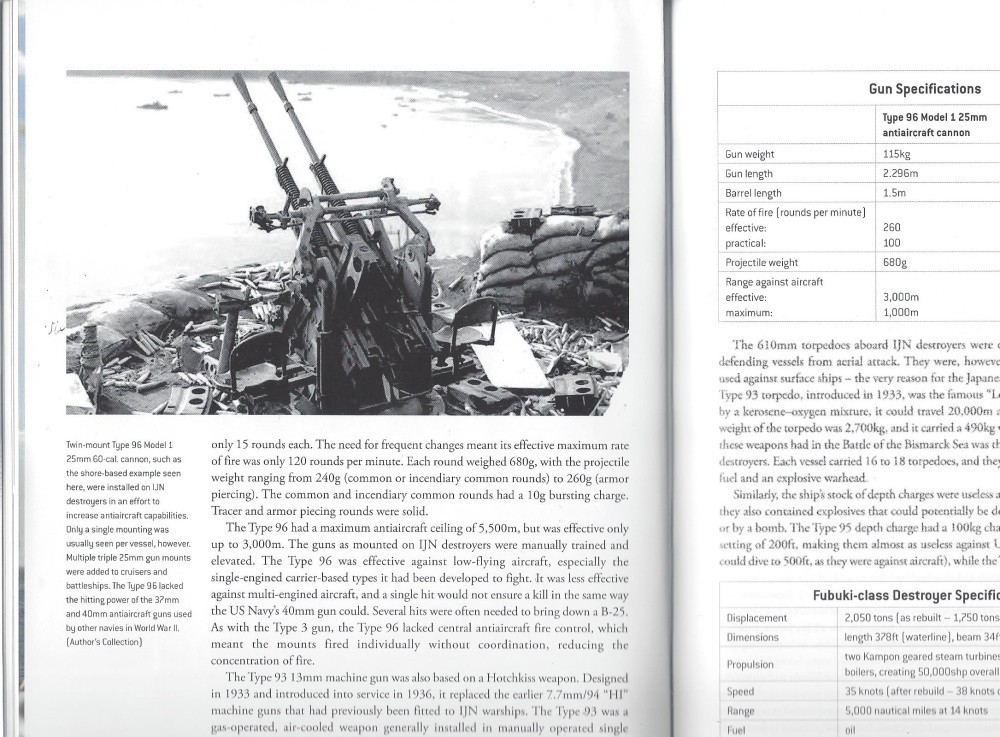
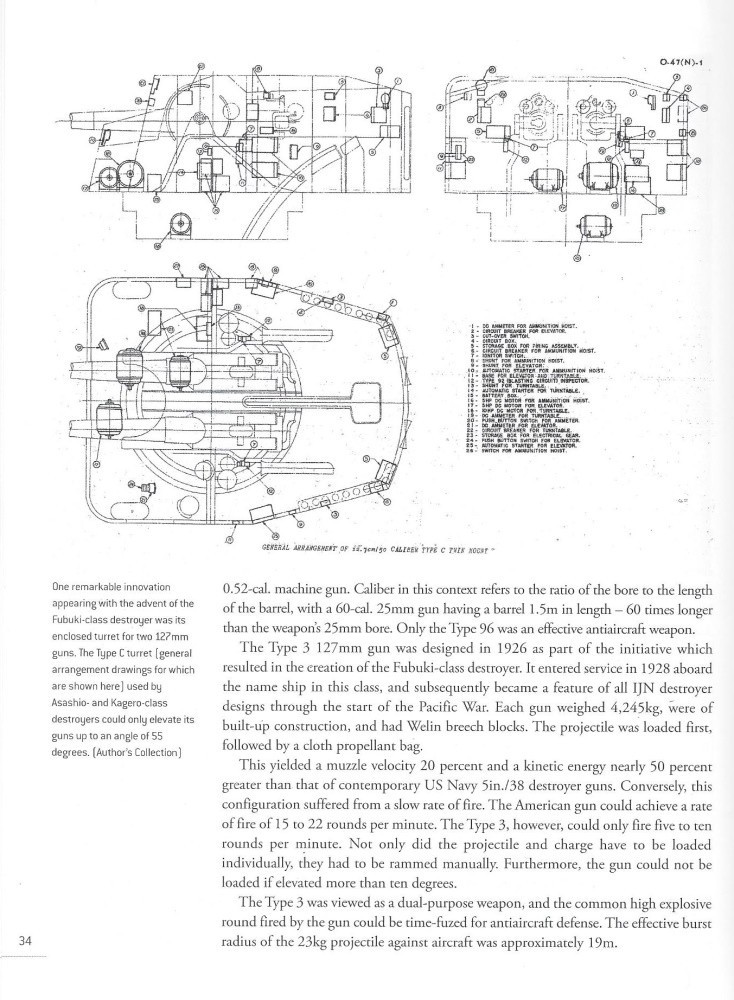

CONCLUSION
Following hot on the heels of the Allied victories at Guadalcanal and Buna, the Bismarck Sea battle demonstrated that Japan could not support their army in the field, and their navy was no longer mostly immune to attacks by Allied medium bombers. Osprey’s B-25 Mitchell vs Japanese Destroyer Battle of the Bismarck Sea 1943 explains the reasons in great detail within the constraints of an 80-page format. Excellent images supports the text. This is one of the more impressive Duel books I have read. I think the typos in the book can mislead and confuse readers new to this subject. Still, modelers and historians should find this an informative and interesting book. Therefore, I recommend this book.
Please remember to mention to Osprey and retailers that you saw this product here - on Aeroscale.
* Amended after original publishing of review.











